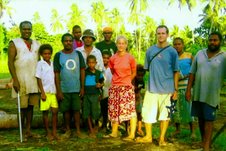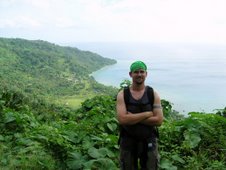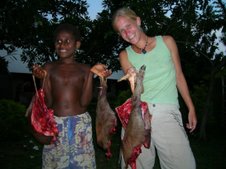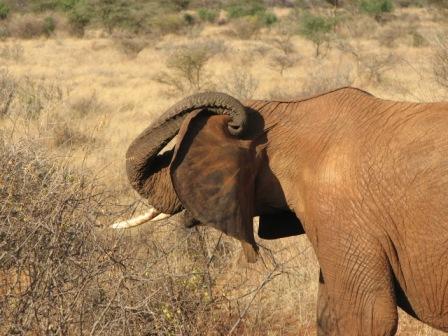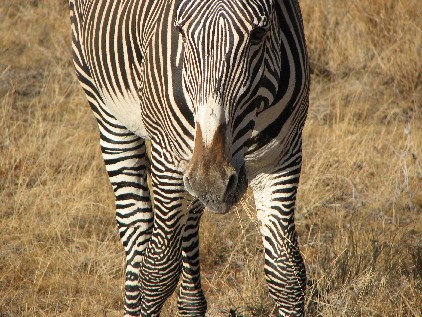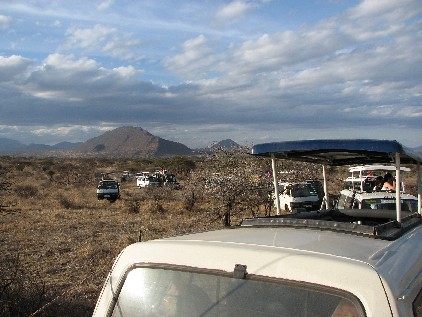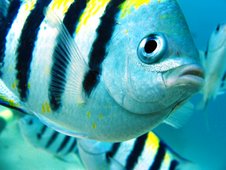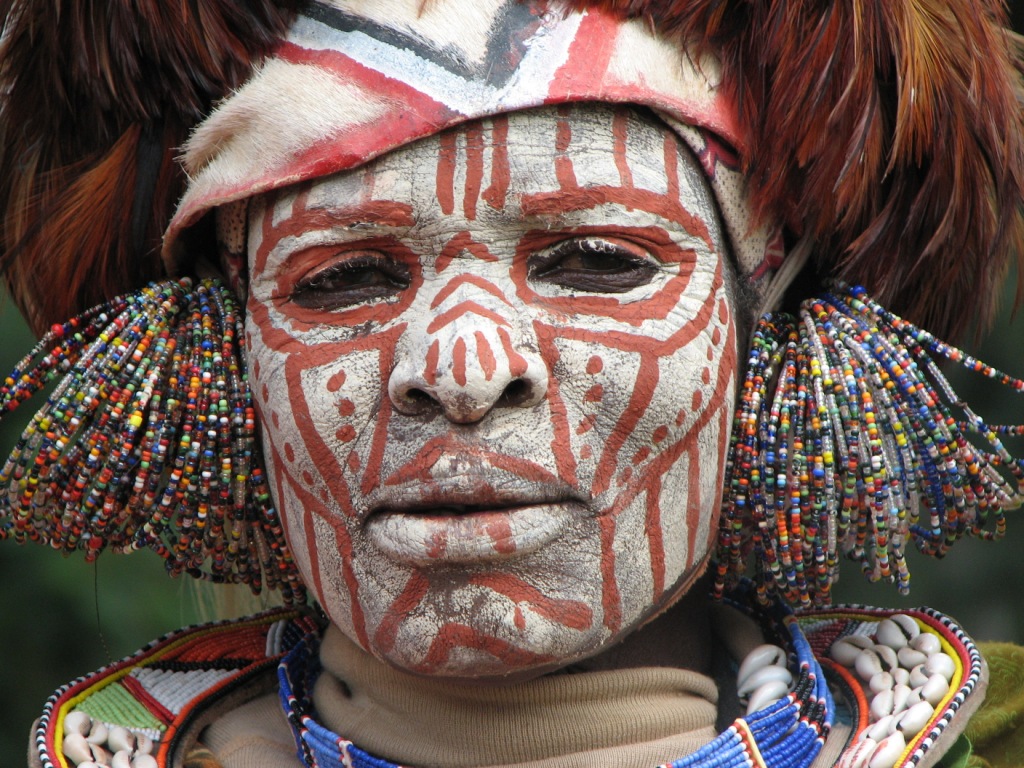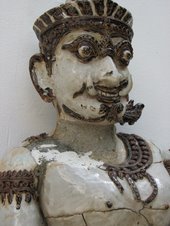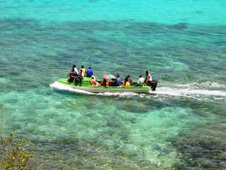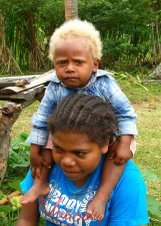Well having spent more than a couple days of our Kenyan

experience in Nairobi it got me thinking: Is "Nairobbery" up to par with its reputation? I believe that the answer is definitely "maybe." The rumor and volunteer mill puts this urban population at around 3.4 million people although we have found downtown Nairobi to be much smaller than would be expected for this populous. Kenyans are adamant that the new government has certainly greatly improved the situation in Nairobi, particularly within the City Center area, and evidence of this is everywhere. Security and police forces are found on every block and are hard to miss nonchalantly carrying Russian assault rifles. I am also told that there are a great deal of police dressed in street clothes. I hardly feel though that the city deserves, what some travelers and guides have given it, the reputation as "the most unsafe city in all of Africa." Don't get me wrong.... the place can feel a bit concerning. Ben and I have been careful of our belongings and haven't ventured out after dark. Would "street-smart" be a

necessary thing to pack when coming to Kenya? Yes.
Well what is Nairobi like then?..... It has the hues and feel of architecture from the 1970's. Unlike many large cities I would say that, barring the natural diversity of the tribal Kenyans themselves, the city is very African... not many wazungu (white people) and just a dash of Indian-ex-pats. Vendors here are aggressive, the bartering is harsh and there are just about two menus or prices for anything that doesn't have a bar-code. (Mzungu prices can be 2-5 times that of a local...a bit frustrating.) Thing to know... nothing here in Kenya is free. Nothing. An example is a local shop keeper that tried to sell Ben and I an old-beaten up cardboard box for 400 Kenyan shillings (nearly $6). We walked away and got another young man to give us one for the price of a soda (50 Ksh). The city does have its charm and so do the Kenyans. They are very political and away of global events and you can have some very friendly debates without risking the loss of a friendly handshake at the end. You can't really blame the people here for having an angle or for competing aggressively for business... life is hard and there is a lot of competition.

Here is a small bit of Nairobi history: almost everything here is less than 100 years old and prior to 1890 was little more than a swamp land with a stream known by the Maasai as "waso nairobi" (cold water). With railways coming onto the African seen the East African railway's company Uganda Railway further developed the area by putting an administrative center here. Nairobi's fate was sealed when the British Protectorate moved their capital from Mombasa to Nairobi in 1901. Even as "permanent structures" went up the town had a different kind of wildlife, as compared to the contemporary night scene, with a lot of wild animals roaming the streets and avenues. Then comes the Hemingway age... the hotels that the British built in the early 1900's catered to the big game hunters that would eventually lead to the crash of the mighty iconic wildlife of the area. The building you see today, like I said think 1970, were build over the demolished colonial ones after independence in 1963. They are mostly bland and boxish.
Moving away from the City Center of Nairobi and common to many other towns in Kenya are

rather unfortunate in terms of sanitation and infrastructure. However all are bustling with activity and there are a myriad of bicycles, donkeys and carts, cattle, goats, herders, pedestrians and street vendors to liven the scene up. Some of the architecture found in the outer villages and towns are really quite beautiful. Many homes and building are made with stone bricks that are cut by hand. The shops and street malls created out of these stones will be about two stories and four stores long, all brightly painted with advertisements like NesCafe, Safaris.com or Selcom (cellular phones). It is actually visually more pleasing than the alternative of having roads lined with billboards.
Well I will let you go from there so I can get to the good stuff... the safari, the history, the scenery and the adventure that is Africa!
-Jessica
 View from the lookout over the Samburu National Park.
View from the lookout over the Samburu National Park. King of the Savanna. Male lion awaits dusk in Amboseli Game Reserve.
King of the Savanna. Male lion awaits dusk in Amboseli Game Reserve. Sun set over the river in Samburu National Park.
Sun set over the river in Samburu National Park. Beast at dusk in the Amboseli Game Reserve.
Beast at dusk in the Amboseli Game Reserve. Walking and talking. Two Maasai men walking in the barren grounds outside Amboseli Game Reserve.
Walking and talking. Two Maasai men walking in the barren grounds outside Amboseli Game Reserve. Cat nap. It is good to be king in the Amboseli Game Reserve.
Cat nap. It is good to be king in the Amboseli Game Reserve.  Dust literally covers most of everything here. In fact, the wildebeest look noticeable older (grayer) here than in "the Mara". Wildlife is not hard to spot moving even hundreds of meters away. All you need to do is follow the smoke trails whisping into the air like far off smoke signals saying, "Over here!". These gray clouds are choking the remaining grasses and it is assumed that their decline will cause most of the ungulates who rely on them to move on (but where?). We even saw an interesting elephant foraging strategy here. A juvenile female would dig the dying grass with the back of her front foot, then proceed to roll it into a ball using its trunk to blow the dust off of it before eventually popping it into its mouth. It was all very well choreographed. And in the afternoon when the winds blow stronger you can see thin twisters of the gray dust shoot into the sky. This situation demands attention, but at least on the surface it appears that attention is not forthcoming. Amboseli is a hard place.
Dust literally covers most of everything here. In fact, the wildebeest look noticeable older (grayer) here than in "the Mara". Wildlife is not hard to spot moving even hundreds of meters away. All you need to do is follow the smoke trails whisping into the air like far off smoke signals saying, "Over here!". These gray clouds are choking the remaining grasses and it is assumed that their decline will cause most of the ungulates who rely on them to move on (but where?). We even saw an interesting elephant foraging strategy here. A juvenile female would dig the dying grass with the back of her front foot, then proceed to roll it into a ball using its trunk to blow the dust off of it before eventually popping it into its mouth. It was all very well choreographed. And in the afternoon when the winds blow stronger you can see thin twisters of the gray dust shoot into the sky. This situation demands attention, but at least on the surface it appears that attention is not forthcoming. Amboseli is a hard place.

 The water that supplies the wetlands here is heavily subsidized by snow melt from Mount Kilimanjaro which slowly makes it way through subterranean rivers, trickling out into this oasis. As many of you may already be aware, the amount of snow on Kilimanjaro has been steadily declining for at least the last thirty years. A simple math equation of annual accumulation minus annual melt off shows this trend year after year. There may even be a time when there is no snow garnishing the top of Africa's highest peak.
The water that supplies the wetlands here is heavily subsidized by snow melt from Mount Kilimanjaro which slowly makes it way through subterranean rivers, trickling out into this oasis. As many of you may already be aware, the amount of snow on Kilimanjaro has been steadily declining for at least the last thirty years. A simple math equation of annual accumulation minus annual melt off shows this trend year after year. There may even be a time when there is no snow garnishing the top of Africa's highest peak.


 We also were fortunate enough to have witnessed an awesome ceremony performed by male elephants not even ten meters from our vehicle. We saw a large group of elephants headed towards one of the swamps - mothers, infants, toddlers, juveniles, and a couple of larger males. It was clear who was the dominant male in the group. He was huge and he was in must (sexually available). Surely his goal was of a romantic nature as he followed behind the group of females.
We also were fortunate enough to have witnessed an awesome ceremony performed by male elephants not even ten meters from our vehicle. We saw a large group of elephants headed towards one of the swamps - mothers, infants, toddlers, juveniles, and a couple of larger males. It was clear who was the dominant male in the group. He was huge and he was in must (sexually available). Surely his goal was of a romantic nature as he followed behind the group of females. 
























